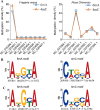MDR: an integrative DNA N6-methyladenine and N4-methylcytosine modification database for Rosaceae
- PMID: 31240103
- PMCID: PMC6572862
- DOI: 10.1038/s41438-019-0160-4
MDR: an integrative DNA N6-methyladenine and N4-methylcytosine modification database for Rosaceae
Abstract
Eukaryotic DNA methylation has been receiving increasing attention for its crucial epigenetic regulatory function. The recently developed single-molecule real-time (SMRT) sequencing technology provides an efficient way to detect DNA N6-methyladenine (6mA) and N4-methylcytosine (4mC) modifications at a single-nucleotide resolution. The family Rosaceae contains horticultural plants with a wide range of economic importance. However, little is currently known regarding the genome-wide distribution patterns and functions of 6mA and 4mC modifications in the Rosaceae. In this study, we present an integrated DNA 6mA and 4mC modification database for the Rosaceae (MDR, http://mdr.xieslab.org). MDR, the first repository for displaying and storing DNA 6mA and 4mC methylomes from SMRT sequencing data sets for Rosaceae, includes meta and statistical information, methylation densities, Gene Ontology enrichment analyses, and genome search and browse for methylated sites in NCBI. MDR provides important information regarding DNA 6mA and 4mC methylation and may help users better understand epigenetic modifications in the family Rosaceae.
Keywords: DNA methylation; DNA sequencing; Plant genetics.
Conflict of interest statement
Conflict of interestThe authors declare that they have no conflict of interest.
Figures




Similar articles
-
MethSMRT: an integrative database for DNA N6-methyladenine and N4-methylcytosine generated by single-molecular real-time sequencing.Nucleic Acids Res. 2017 Jan 4;45(D1):D85-D89. doi: 10.1093/nar/gkw950. Epub 2016 Oct 18. Nucleic Acids Res. 2017. PMID: 27924023 Free PMC article.
-
Advances in mapping the epigenetic modifications of 5-methylcytosine (5mC), N6-methyladenine (6mA), and N4-methylcytosine (4mC).Biotechnol Bioeng. 2021 Nov;118(11):4204-4216. doi: 10.1002/bit.27911. Epub 2021 Aug 20. Biotechnol Bioeng. 2021. PMID: 34370308 Review.
-
Sources of artifact in measurements of 6mA and 4mC abundance in eukaryotic genomic DNA.BMC Genomics. 2019 Jun 3;20(1):445. doi: 10.1186/s12864-019-5754-6. BMC Genomics. 2019. PMID: 31159718 Free PMC article.
-
DNA Modification Patterns within the Transposable Elements of the Fig (Ficus carica L.) Genome.Plants (Basel). 2021 Feb 27;10(3):451. doi: 10.3390/plants10030451. Plants (Basel). 2021. PMID: 33673593 Free PMC article.
-
Developmental processes in the Rosaceae through the lens of DNA and RNA methylation.Planta. 2025 Feb 8;261(3):54. doi: 10.1007/s00425-025-04623-2. Planta. 2025. PMID: 39921711 Free PMC article. Review.
Cited by
-
i6mA-Fuse: improved and robust prediction of DNA 6 mA sites in the Rosaceae genome by fusing multiple feature representation.Plant Mol Biol. 2020 May;103(1-2):225-234. doi: 10.1007/s11103-020-00988-y. Epub 2020 Mar 5. Plant Mol Biol. 2020. PMID: 32140819
-
Developing a Multi-Layer Deep Learning Based Predictive Model to Identify DNA N4-Methylcytosine Modifications.Front Bioeng Biotechnol. 2020 Apr 21;8:274. doi: 10.3389/fbioe.2020.00274. eCollection 2020. Front Bioeng Biotechnol. 2020. PMID: 32373597 Free PMC article.
-
Recent Advance in Single-Molecule Fluorescent Biosensors for Tumor Biomarker Detection.Biosensors (Basel). 2024 Nov 7;14(11):540. doi: 10.3390/bios14110540. Biosensors (Basel). 2024. PMID: 39589999 Free PMC article. Review.
-
DeepRice6mA: A convolutional neural network approach for 6mA site prediction in the rice Genome.PLoS One. 2025 Jun 18;20(6):e0325216. doi: 10.1371/journal.pone.0325216. eCollection 2025. PLoS One. 2025. PMID: 40531834 Free PMC article.
-
Isoform Sequencing Provides Insight Into Freezing Response of Common Wheat (Triticum aestivum L.).Front Genet. 2020 Jun 11;11:462. doi: 10.3389/fgene.2020.00462. eCollection 2020. Front Genet. 2020. PMID: 32595694 Free PMC article.
References
LinkOut - more resources
Full Text Sources
Molecular Biology Databases

